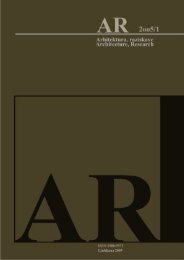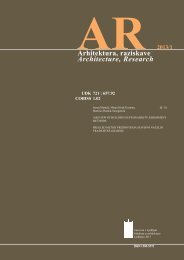AR 2010/1 - Fakulteta za arhitekturo - Univerza v Ljubljani
AR 2010/1 - Fakulteta za arhitekturo - Univerza v Ljubljani
AR 2010/1 - Fakulteta za arhitekturo - Univerza v Ljubljani
Create successful ePaper yourself
Turn your PDF publications into a flip-book with our unique Google optimized e-Paper software.
<strong>AR</strong> <strong>2010</strong>/1<br />
<strong>2010</strong> / 1 <strong>AR</strong><br />
ZUPANČIČ-STROJAN, Tadeja, JUVANČIČ, Matevž. Virtual<br />
space design : a flexible learning model. V: ÇAĞDAŞ, Gülen<br />
(ur.), ÇOLAKOĞLU, Birgül (ur.). Computation : the new realm<br />
of architectural design : proceedings of the 27th Conference<br />
on Education and Research in Computer Aided Architectural<br />
Design in Europe, September 16-19, 2009, Istanbul, Turkey.<br />
1st ed. Istanbul: Istanbul Technical University Faculty of<br />
Architecture: Yildiz Technical University, cop. 2009, str. 137-<br />
144, ilustr. [COBISS.SI-ID 2325380]<br />
Borut Juvanec<br />
E<strong>AR</strong>TH <strong>AR</strong>CHITECTURE AND SLOVENIA<br />
Mediterra 2009, 1 st Mediternean Conference on Earth<br />
Architecture<br />
DiArch Facolta di Architectura, Italy<br />
Escola Superior Gallaecia, Portugal<br />
CRATerre-Ecole Nationale Superieure d’Architecture de<br />
Grenoble, France<br />
13. – 16. marec 2009, Sardinija, Italija<br />
http://www.uni-terra.org/events/mediterra-2009<br />
Na povabilo prof Mariane Correia iz ESG Gallaecia (Portugalska)<br />
sva se s kolegom dr Domnom Zupančičem udeležila 1ere<br />
Conference Mediterraneenne sur L'Architecture de Terre med<br />
13. in 16. marcem 2oo9 na Univerzi v Cagliariju, Sardinija,<br />
Italija.<br />
Kongres so organizirali pod pokroviteljstvom UNESCO World<br />
Heritage Centre, ICCROM Roma, ICOMOS Paris, GCI Getty<br />
Conservation Institute Los Angeles:<br />
Universita di Cagliari, RAS Regione Autonoma di Sardegna,<br />
ESG Escola Superior Gallaecia, CRATERRE-ENSAG Centre<br />
Int. de la Construction en Terre pri L'Ecole Nationale Superiere<br />
sur l'Architecture de Grenoble, France (UNESCO Chair for<br />
Earthen Architecture).<br />
Sam sem član Comitato Scientifico kongresa, recenziral sem<br />
štiri prispevke <strong>za</strong> objavo, bil sem v predsedstvu 4. seje.<br />
Kongres je tekel tri dni s predavanji in en dan z vodenim<br />
ogledom. Na kongresu je bilo 2oo udeležencev s 14o nastopi, od<br />
tega je natisnjenih 75.<br />
Na kongresu smo sodelovali strokovnjaki iz 36 držav sveta.<br />
S kolegom sva na Sardiniji zbirala gradivo o kamnitih<br />
konstrukcijah, predvsem na temo 'pozzo sacro' ali 'sveti<br />
vodnjak'. Dokumentirala sva vodnjake iz obdobja nuragijske<br />
kulture (17oo do 385 pred štetjem): Santa Vittoria (Serri), Su<br />
Tempiesu (Nuoro), Predio Canopoli (Perfugas) in grobnico<br />
Campu Lontanu (Sassari).<br />
Izvleček<br />
Theory on building materials includes all the natural row<br />
materials: all between water and stone. Cut or undressed stone<br />
can be composed directly, wood has to be hewed, clay can<br />
be moulded, dried or burned. The first two techniques need<br />
technical, the last one needs technological work.<br />
Techniques depend on material. Turf, a combination of two<br />
layers: soil and grass, can be composed in layers only. Moulded<br />
clay has to be reinforced, with branches of oily shrubs mostly.<br />
Ramned clay is the same material, but built-in between wooden<br />
wainscot and pressed hard. Adobe system is made of raw clay<br />
block, dried on air or on the sun. All these compositions need<br />
maintaining during all the use. After the use can clay in these<br />
constructions become strewed material again. Construction of<br />
raw clay needs water for forming as well as for its effect.<br />
Burned bricks are technologically changed material and can<br />
not be returned into clay after burning. The point of elements<br />
with the same dimensions is proportional system. For bricks are<br />
mostly in use the formula 1 : 2 : 4 (width : height : length), which<br />
enables forming of corners, and variable thickness of the walls.<br />
Clay can be usefull material for connection between wooden<br />
beams, stones and bricks. On the surface clay can be used as<br />
plaster or coating, technically; with technological changes clay<br />
appears as enamel or even as kaolin in porcelain.<br />
Examples from Mediterranean and Near East can be found as<br />
moulded walls in all the North Africa,Yemen. Ramned clay<br />
can be seen from Morocco to Caucasus Today too, as well as<br />
adobe.<br />
Tiles as roofing material can be of burned clay, but better tiles<br />
have enamel surface, with double burning. Not only quality,<br />
tiles appearance with coloured surface is very typical for all<br />
the Mediterranean part of Europe, and is important part of its<br />
architecture. Porcelain technique for enamel plates or glazed<br />
tiles is used mostly on the Western part of Europe, in Spain and<br />
in Portugal, with its typical ajuleisos.<br />
In Slovenia, clay architecture is very often, especially in its<br />
Nort-East part, also in combination with the wood, mostly with<br />
thatched roofs. Today it is matter of scientific work only.<br />
JUVANEC, Borut. Earth architecture and Slovenia. V: ACHENZA,<br />
Maddalena (ur.), CORREIA, Mariana (ur.), GUILLAUD, Hubert<br />
(ur.). Mediterra 2009, (Architettura sostenibile / documenti). 1a ed.<br />
Monfalcone: EdicomEdizioni, cop. 2009, str. 71-84, ilustr.<br />
Borut Juvanec<br />
MAN'S FIRST STEPS INTO PROPORTION<br />
THEORY<br />
Symmetry: Art and Science<br />
International Society for the Indisciplinary Study of<br />
Symmmetry ISIS<br />
14. – 19. september 2009, Wroclaw – Cracow, Poland<br />
Kongres Symmetry of Forms and Structures je tekel v Wroclawu<br />
in v Cracowu v okviri ISIS (International Society for the<br />
Interdisciplinary Study of Symmetry, Melbourne, Budapest).<br />
Na kongres me je povabil profesor Denes Nagy, udeležila sva<br />
se ga s kolegom dr Zupančičem, žal le <strong>za</strong>dnje tri dni kongresa.<br />
Na kongresu je presenetilo izjemno mednarodno <strong>za</strong>stopstvo,<br />
s poudarkom na Japonski. Tradicija teorije je tam posebno<br />
pomembna in še vedno živa, tudi na področju proporcijskih<br />
sistemov.<br />
87

















